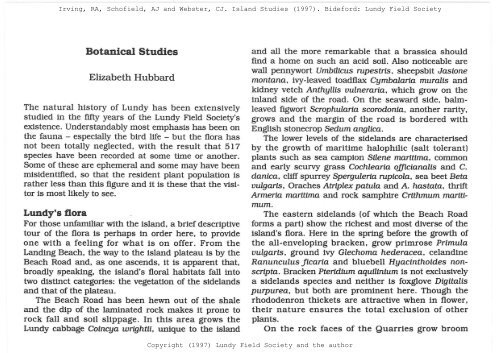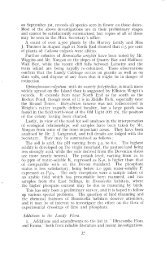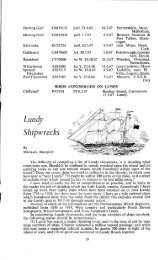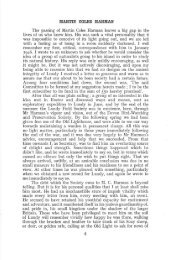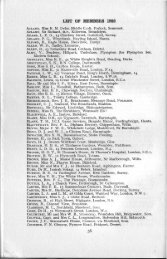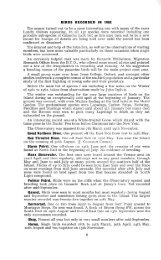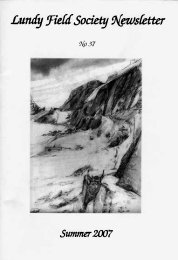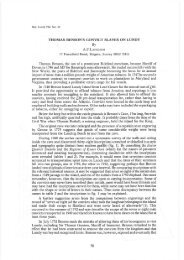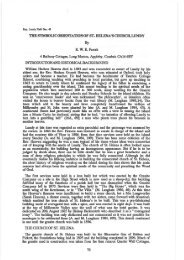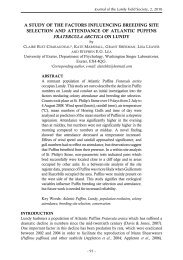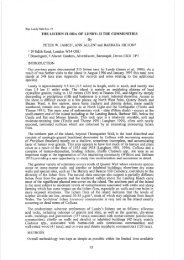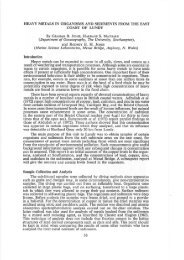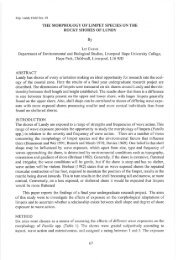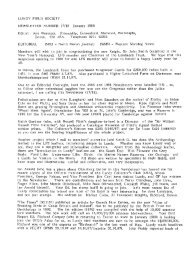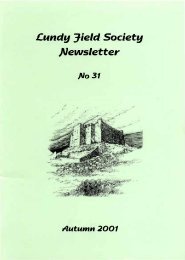You also want an ePaper? Increase the reach of your titles
YUMPU automatically turns print PDFs into web optimized ePapers that Google loves.
Irving, RA, Schofield, AJ and Webster, CJ. Island <strong>Studies</strong> (1997). Bideford: <strong>Lundy</strong> Field SocietyISLAND STUDIESattempted to photograph all of the flowers on theisland. Despite some addition s and some losses, thetwo lists tally well.In 1979, I had access to lis ts m ade by Dr F.R.Elliston Wright made in 1933-1935, and published inthe Journal of Botany. In his preface Dr Wright saysthat he considers Loyd's list, which was itself mainlyderived from an earlier list made by Chanter, to be"wholly unreliable". Nevertheless it is interesting thatmost of the plants listed are still to be found there.Dr Wright's outstanding contribution to the study ofthe <strong>Lundy</strong> flora was, of course, the identification ofthat primitive brassica, a fertile hybrid, the <strong>Lundy</strong> cabbage,successively named in the scientific terminologyBrasstcella wrightii in 1936 by Professor O.E. Schultz,and then amended subsequently to first Rhyncosinaplsand then Coincya wrlghtll. A number of articles haveappeared in the Annual Reports on the <strong>Lundy</strong> cabbage(Marren 1971; Cassidi 1980; Irving 1984), all of whichdemonstrate convincingly how the plant has extendedits range from its original locality on the metamorphicDevonian slate northwards along the granite sidelandsas far as Knight Templar Rock. A note in the 1993Annual Report suggests a total of 3,000 p lantsbetween the Landing Bay and Quarter Wall.In the 1982 Annual Report, an important article onthe <strong>Lundy</strong> vegetation appeared, written by Trudy A.Watt and K.J. Kirby (Watt & Kirby 1982). This took theform of a systematic survey of the whole island withsampling of one metre squares at 200 m intervals on143anE-W axis and 500 m intervals on aN-Saxis. Therewere 45 sampling plots in all. The survey demonstratedthe differences in vegetation between the east andthe west sides. It is a valuable addition to the study ofthe island flora but because of the limitations of thesampling method, many prevalent species wentunrecorded. In the 30th Annual Report (Watt 1979),Trudy Watt reported a survey of the grass growth on<strong>Lundy</strong>. This was followed a few years later by R.Takagi-Arigho publishing a list of the grasses found onthe island between the months of May and October(Takagi-Arigho 1986).Preliminary work by Mr P.O. Garbutt and Professorand Mrs Harvey, quoted in the 5th Annual Report(1951), on the differences in plant population betweenthe east and west coasts, was followed in the followingyear by a more detailed study of the slopes on thenorthern aspect of Jenny's Cove on the west side, andthe north flank of Brazen Ward on the east side. Thegradients of the slopes and the pH and chloride contentof the soil were measured, with the frequency ofvarious species being noted against these parameters.A vegetation survey was carried out in 1971 byAlice Dunn and Helen Bristow (Dunn & Bristow 1971 lwith the .aim of helping Colin Taylor complete a map ofthe island vegetation. He had already surveyed thesouth end and the cultivated fields. They studiedAckland's Moor, Pondsbury, Middle Park and theNorth End.In 1973, Paul Wilkins and Julian Debham under-Copyright (1997) <strong>Lundy</strong> Field Society and the author
144Irving, RA, Schofield, AJ and Webster, CJ. Island <strong>Studies</strong> (1997). Bideford: <strong>Lundy</strong> Field SocietyBOTANICAL STUDIEStook a survey of the recolonisation of the North Endafter the fires there in the 1930s (Wilkins & Debham1973). They found there was little difference in soildepth or plant variety between the burned andunburned areas. Heather Call una vulgaris. bellheather Erica cineraria and thrift Armeria maritimawere the most common flowering plants and of thenon-flowering plants, lichens, sedges, rushes andgrasses dominated. They believed that lichens played asignificant part in soil development.In 1974, Dr H .C. Dawkins surveyed the fescueblanket on the east end of Rat Island, which he foundto be very deep (Dawkins 1974a). He then surveyed thewest end, which had been burned by a flare and notedthe plants which were recolonising that area. Thesewere important observations since Rat Island is theonly part of <strong>Lundy</strong> left ungrazed. In the same year, DrDawkins also studied the southern slopes ofHangman's Hill below the Ugly, which he likened to asmall scale version of a forest with a canopy layer ofblackthorn, gorse and hawthorn, and a basal layer ofshade-loving plants (Dawkins 1974b).Rhododendron Rhododendron ponticum was a plantintroduced by the Heaven family into the Millcombearea in the nineteenth century and it soon began to. spread. J.R. Chanter in 1877 comments in his book<strong>Lundy</strong> Island that the plants had become naturalisedand were spreading. A fire in 1926 destroyed most ofthe vegetation between the northernmost quarry andSt Helens Coombe, but the rhododendron regeneratedfrom the surviving underground roots and rapidlyrecolonised the whole area. P.R. Marren conducted asurvey in 1972 and recorded the spread of seedlings tothe island plateau. Since then much has been done tocheck the plant's spread and cut back establishedplants.Other deliberately introduced species includeEscallonia and Hebe bushes beside the path leading toMillcombe. It is clear from the study of photographs ofthe house and from early written records that manytrees have been introduced to the island. Perhaps themost unexpected of these is the Japanese spindleEuonymus japonica. It is possible that birds may beresponsible for the arrival of some of the berriedspecies.In 1978 and 1979, Dr J.J. George and others studiedthe flora of the <strong>Lundy</strong> ponds and the results werepublished in the 30th and 31st Annual Reports. Thereis a further study in the 37th Report. The plants foundhad already been included in the main lists.Additional notes and flower lists have appeared overthe years starting with the 1st Report when a permanentquadrat was staked out in a deeply burned areawest of Middle Coombe. A list in the second reportcompiled by a number of Field Society members wasadded to the list in fljracombe Flora and Fauna. Sincethen lists have been contributed by Mrs Ann Westcott(e.g. Westcott 1969 & 1971) and others. One particularlyinteresting note was made in 1968 by Canon J .Stafford Wright who found honewort Trinia glauca -Copyright (1997) <strong>Lundy</strong> Field Society and the author
Irving, RA, Schofield, AJ and Webster, CJ. Island <strong>Studies</strong> (1997). Bideford: <strong>Lundy</strong> Field SocietyISLAND STUDIESunrecorded elsewhere (Wright 1968).A report in 1980 by Mr Rob Randall tells how hefailed to find purple spurge Euphorbia peplls (Randall1980). He also examined the status of balm-leaved figwortScrophularia scorodonia, which was becomingrare on the north coasts of Devon and Cornwall, butwhich was still flourishing on the east coast of <strong>Lundy</strong>.Fungal species are listed in the 14th, 21st, 22nd,23rd, 38th,, and 43rd Annual Reports. Lichen speciesare listed in the 3rd, 13th and 23rd Reports, with amajor lichen survey currently being undertaken byPeter James and Anne Allen. Liverworts are reported inthe 13th and 26th Reports; and freshwater diatoms inthe 3rd Annual Report.TreesWith the help of Mr W.H. Dyer I surveyed the treesfound growing on the island in 1969 and 1970. 433trees were counted in the eight main wooded areas,which were all on the east side. Sycamore Acer pseudoplatanuswas by far the most successful species andshowed the most signs of regeneration. ElderSambucus nigra, willow Salix atrocinerea·and S. capreaand ash Fraxinus excelsior were the next most numerous.All trees showed signs of wind damage where theywere unprotected by the bulk of the island. During thesummer of 1970, beech Fagus sylvatica, sessile oakQuercus petraea and three species of pine Pinus spp.,were planted on the north side of Millcombe in thememory of Albion Harman.145Tree planting has taken place since then and thereare two reports of this. Further planting was undertakenin 1983 in Millcombe Valley, StJohn's Valley, northof the Ugly, and St Helen's Copse. Trees have beenplanted to replace mature and dying trees and also innew areas in the hope that they will support wildlifeand the expectation that they will enhance the beautyof the island. The species chosen were mainly thosealready growing on the island, but field maple Acercampestre, aspen Populus tremula and a strawberrytree Arbutus unedo were also planted. A.J. Parsonsquestioned the wisdom of planting trees in St John'sValley, holding that its ecological importance lay in itsopen nature. P. de Groot replied to this in I984 sayingthat the Pinus muricata, which had been planted closeto the edge of the road to provide shelter, had not faredwell and many had died. The aspen and alder hadbeen planted to provide shelter for birds.Management studiesIn 1988, the then warden Neil Willcox, in conjunctionwith the Committee of the <strong>Lundy</strong> Field Society, producedthe first draft of A Management Plan for <strong>Lundy</strong>(Willcox 1988); this was developed over the next fewyears. In 1994, English Nature published a managementplan for the Marine Nature Reserve together withthe island's Site of Special Scientific Interest, entitledManaging <strong>Lundy</strong>'s Wildlife (English Nature 1994).An important addition to the botanical studiesmentioned above was the survey of the island's floraCopyright (1997) <strong>Lundy</strong> Field Society and the author
146Irving, RA, Schofield, AJ and Webster, CJ. Island <strong>Studies</strong> (1997). Bideford: <strong>Lundy</strong> Field SocietyBOTANICAL STUDIESand fauna undertaken in 1986 by the National Trust,owners of the island since 1969. The ensuing report(National Trust 1991) was based on the observations ofa team of scientists during a visit to the island,combined with references to previously publishedstudies and consultations with involved organisationsand specialist journals. The report is divided into anumber of sections describing the different vegetativecommunities which occur on <strong>Lundy</strong>. It highlights thepresence of a number of rare plants on <strong>Lundy</strong> such asthe <strong>Lundy</strong> cabbage Coincya wrightii, balm-leavedfigwort Scrophularia scordonia, dwarf adders tonguefern Ophioglossum azoricum, and hay-scented bucklerfern Dryopteris aemula. Mention is made too of therecords of plants which have appeared from time totime in disturbed ground, such as thorn apple Daturastramonium, henbane Hyoscyamus niger and smallfloweredcatchfly Silene anglica. The report includesuseful comments on the accuracy of some speciesidentifications which have been included in floral lists.In addition to flowering plants, mosses, liverworts,lichens, fungi, sedges, rushes and grasses were includedin the survey. Besides reporting on what was found,the report comments on the interaction between thevegetation, the grazing of farm animals, and the fauna.It also contains some suggestions for improving theisland's overall ecological balance.In conclusion<strong>Lundy</strong> provides opportunities for further botanicalstudies and it may be that, because these can becarried out in a circumscribed geographical area,comparisons can be made and lessons learned whichcan be applied elsewhere in what is, on the whole,inhospitable terrain.Copyright (1997) <strong>Lundy</strong> Field Society and the author
Irving, RA, Schofield, AJ and Webster, CJ. Island <strong>Studies</strong> (1997). Bideford: <strong>Lundy</strong> Field SocietyISLAND STUDIESReferencesAnon. 1962. The Atlas of British Flora.Cassidi, M D, 1981. Status of the <strong>Lundy</strong> Cabbage Rhyncosinapis wrtghtii. Annual Report of the <strong>Lundy</strong>Field Society 31, 64-67.Chanter, J R, 1877. <strong>Lundy</strong> Island- a monograph.Dawkins, H C, 197 4a. The fescue blanket of Rat Island. Annual Report of the <strong>Lundy</strong> Field Society 25, 53-55.Dawkins, 1974b. The Ugly nanodrymion. Annual Report of the <strong>Lundy</strong> Field Society 25, 55-56.Dunn, A, and Bristow, H, 1971. Vegetation survey- <strong>Lundy</strong> 1971. Annual Report of the <strong>Lundy</strong> FieldSociety 22, 42-43.English Nature. 1994. Managing <strong>Lundy</strong>'s Wildlife: a Management Planfor the Marine Nature Reserveand the Site of Special Scientific Interest. Okehampton: English Nature.Garbutt, P D, 1952. A study of the vegetation of the coastal slopes of <strong>Lundy</strong>. Annual Report of the <strong>Lundy</strong>Field Society 6, 36-49.Gibson, L, 1992. <strong>Lundy</strong> flora, 1989-1992. Annual Report of the <strong>Lundy</strong> Field Society 43, 104-112.Hubbard, E M, 1971. A contribution to the study of the <strong>Lundy</strong> flora. Annual Report of the <strong>Lundy</strong> FieldSociety 22, 13-24.Irving, R A, 1984. Notes on the distribution of the <strong>Lundy</strong> cabbage Rhyncosinapts wrightit.Annual Report of the <strong>Lundy</strong> Field Society 35, 25-27.Langham, A & M 1970. <strong>Lundy</strong>. Newton Abbot: David & Charles.Loyd, L R W, 1925. <strong>Lundy</strong>, its history and natural history. London: Longmans.Marren, P R, 1971. The <strong>Lundy</strong> Cabbage. Annual Report of the <strong>Lundy</strong> Field Society 22, 27-31.National Trust. 1991. Biological survey- <strong>Lundy</strong>, Devon. 1986 survey. Spitalgate, Cirencester: NationalTrust Biological Survey.Palmer, M G, 1946. Ilfracombejlora andfauna.Randall, R, 1980. The purple splurge [sic). Annual Report of the <strong>Lundy</strong> Field Society 31, 70.Takagt-Arigho, R, 1986. Notes on <strong>Lundy</strong> Graminae. Annual Report of the <strong>Lundy</strong> Field Society 37, 47-50.Watt, T A, 1979. Grass growth on two areas of <strong>Lundy</strong> in June 1978. Annual Report of the <strong>Lundy</strong> Field Society30, 37-38.147Copyright (1997) <strong>Lundy</strong> Field Society and the author
Irving, RA, Schofield, AJ and Webster, CJ. Island <strong>Studies</strong> (1997). Bideford: <strong>Lundy</strong> Field SocietyPlate 23<strong>Lundy</strong> cabbageCoincya wrightii(Lorna Gibson)BOTANICAL STUDIES -ELIZABETH HUBBARDCopyright (1997) <strong>Lundy</strong> Field Society and the author
+--Irving, RA, Schofield, AJ and Webster, CJ. Island <strong>Studies</strong> (1997). Bideford: <strong>Lundy</strong> Field SocietyPlate 24Flowers of the <strong>Lundy</strong> cabbageCoincya wrightii(Lorna Gibson)BOTANICAL STUDIES -ELIZABETH HUBBARDCopyright (1997) <strong>Lundy</strong> Field Society and the author
Irving, RA, Schofield, AJ and Webster, CJ. Island <strong>Studies</strong> (1997). Bideford: <strong>Lundy</strong> Field SocietyPlate 25Flowers of the balm-leaved figwort Scrophularia scorodonia (Lorna Gibson)BOTANICAL STUDIES -ELIZABETH HUBBARDCopyright (1997) <strong>Lundy</strong> Field Society and the author
Irving, RA, Schofield, AJ and Webster, CJ. Island <strong>Studies</strong> (1997). Bideford: <strong>Lundy</strong> Field SocietyPlate 26Bog asphodelNarthecium ossifragum(Lorna Gibson)BOTANICAL STUDIES -ELIZABETH HUBBARDCopyright (1997) <strong>Lundy</strong> Field Society and the author
Irving, RA, Schofield, AJ and Webster, CJ. Island <strong>Studies</strong> (1997). Bideford: <strong>Lundy</strong> Field SocietyPlate 27Heath spotted orchidDactylorhiza maculata subsp. ericetorum(Lorna Gibson)BOTANICAL STUDIES -ELIZABETH HUBBARDCopyright (1997) <strong>Lundy</strong> Field Society and the authorIII
Irving, RA, Schofield, AJ and Webster, CJ. Island <strong>Studies</strong> (1997). Bideford: <strong>Lundy</strong> Field SocietyPlate 28Bog pimpernel Anagallis tenella (Lorna Gibson)BOTANICAL STUDIES- ELIZABETH HUBBARDCopyright (1997) <strong>Lundy</strong> Field Society and the author
Irving, RA, Schofield, AJ and Webster, CJ. Island <strong>Studies</strong> (1997). Bideford: <strong>Lundy</strong> Field SocietyPlate 29Carpet of thrift Armeria maritima on the west sidelands (Lorna Gibson)BOTANICAL STUDIES -ELIZABETH HUBBARDCopyright (1997) <strong>Lundy</strong> Field Society and the author


